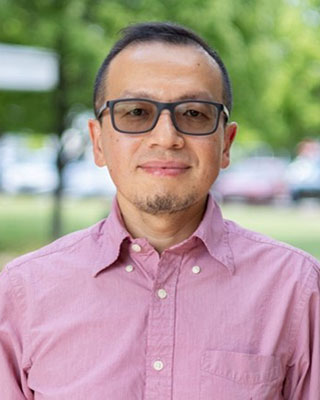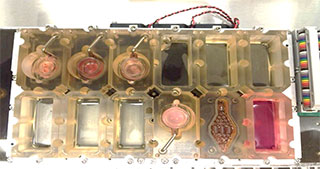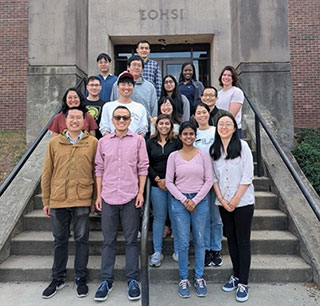December 18, 2024

Xiao, an associate professor at Rutgers University, studies how environmental exposures affect women’s reproductive health. (Photo courtesy of Rutgers University)
A healthy pregnancy requires a series of complex processes to run flawlessly. Multiple organs must constantly communicate with each other. Various hormones need to be secreted at the right time and at the right levels.
Scientists studying women’s reproductive health have tried to recreate this complexity in the lab, but it has been difficult. To address this challenge, NIEHS-funded researcher Shuo Xiao, Ph.D., developed a miniature model that recreates the dynamics of the female reproductive tract. These replicas allow scientists to more accurately study how environmental exposures affect infertility and other reproductive health outcomes.
Working under the guidance of Xiaoqin Ye, Ph.D., Xiao received his doctorate in female reproductive toxicology at the University of Georgia. There, he used mouse models to study how exposure to endocrine disrupting chemicals affect embryo implantation in the uterus, a critical step for a successful pregnancy.
For his postdoctoral research, he continued investigating how the environment affects women’s reproductive health, with two major differences.
“The uterus is only one component of the female reproductive system. I wanted to expand my research to incorporate other organs, like the ovary, to get a more complete picture,” he said. “And I wanted to reduce the use of whole animals in my research. Although animal models are a critical part of toxicology research, they also are costly, time consuming, and come with animal welfare concerns.”
Replicating the Female Reproductive Tract

The female reproductive system-on-a-chip mimics a woman’s 28-day menstrual cycle. It is made up of several small wells, each containing cells that grow into mini 3D reproductive or liver organs. The wells are connected by tiny channels to simulate how the organs communicate with each other in the body. (Image from Xiao et al., Nat Commun, 2017)
Those aspirations led Xiao to Northwestern University where he joined a multidisciplinary team, led by Teresa Woodruff, Ph.D., that developed an “organs-on-a-chip” device to mimic the female reproductive tract.
Developed in part with funding from NIEHS, the device contains cells from four reproductive organs – the ovaries, fallopian tubes, uterus, and cervix – that grow into organoids, a 3D structure that mimics the function of an organ. These organoids are connected by a series of small tubes that carry hormones and other signals between them. Taken together, the miniature chip replicates the hormone fluctuations and cellular changes that occur over a woman’s menstrual cycle. In addition, the researchers connected a mini 3D liver to the device to replicate how the reproductive system reacts to a drug or toxin after it has been metabolized by the liver.
Fine Tuning for Toxicology
Xiao recognized the immense potential of the chip platform for chemical toxicity testing; however, the original method needed some tweaking.
“With the initial device, it could take months to test a chemical at different doses to determine its toxicity. I wanted to optimize the approach so we could use the device to rapidly screen a broad range of chemicals.”
With an NIEHS career development award, Xiao moved to the University of South Carolina to focus on fine tuning one component of the device for toxicity testing: the follicle. The follicle is a small sac in the ovary that contains an egg and produces hormones crucial for ovulation and fertilization. Environmental exposures that alter follicle hormone secretion or egg quality may reduce a woman’s fertility.
Under the mentorship of Jodi Flaws, Ph.D., and Mary Zelinski, Ph.D., Xiao developed a method, called vitrification, to freeze immature follicles so they can be stored long-term, thus creating a ready-to-use ovarian follicle bank for high-throughput toxicity screening. He demonstrated that, when thawed, preserved cells behaved on par with fresh follicles. Specifically, warmed follicles grown in the “ovary-on-a-chip” environment, developed into 3D organoids, released reproductive hormones, initiated ovulation, produced a mature egg cell, and had similar expression of genes important in these processes.
Taking inspiration from his postdoctoral work and with funding from a second NIEHS grant, Xiao is now connecting a liver organoid to the ovary-on-a-chip. This addition will better mimic how follicles respond to toxins in the body that have been transformed by liver.
Oceans and Ovaries
While at the University of South Carolina, Xiao linked up with Geoffrey Scott, Ph.D., director of the university’s Oceans and Human Health Center, which is funded in part by NIEHS. Scott sparked Xiao’s interest in how toxins produced by certain species of aquatic algae may affect ovarian health. Using his ovary-on-a-chip method, Xiao demonstrated that exposure to a common algal toxin called microcystin disrupted follicle maturation and ovulation.
“Our findings suggest that women exposed to microcystins through contaminated food or water, or during water sports, may experience ovarian dysfunction, including irregular menstrual cycles and infertility,” he said. “This is particularly relevant as warmer temperatures increase the growth of algae that produce harmful toxins.”
Now a tenured associate professor at Rutgers University, Xiao continues to explore how a extreme weather may impact women’s reproductive health. With additional funding from NIEHS, he examines how co-exposure to extreme heat and algal toxins affect female fertility. At the NIEHS-funded Rutgers Center for Environmental Exposures and Disease (CEED) he coordinates research activities among center scientists working to assess and reduce the impact of extreme weather on women’s health.
Passing it On

Xiao, shown front center left, poses for a photo with the team of postdoctoral and graduate students who conduct research in his lab. (Photo courtesy of Xiao).
The CEED Center has been instrumental in Xiao’s career growth.
“Senior CEED members, especially Lauren Aleksunes, Debra Laskin, Andrew Gow, and Helmut Zarbl, helped me develop my grant writing skills, taught me how to manage a lab, and how to balance my research and teaching responsibilities,” he said. “Without them, I would not have made it this far.”
Now with six postdocs and several graduate students in his lab, Xiao is passing that knowledge on to the next generation.
“I try to follow the example of my mentors and share what I’ve learned along the way with young scientists. I work with them to find a project that matches their motivation and interests,” he said. “It’s about preparing the next generation of researchers, so they are equipped to conduct research aimed at improving women’s reproductive health.”


